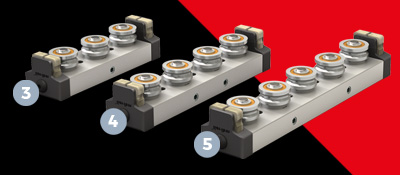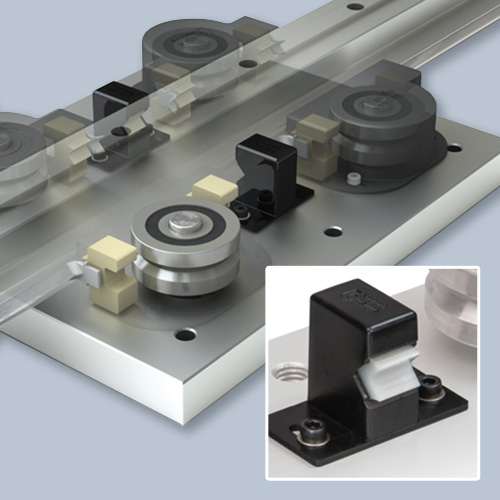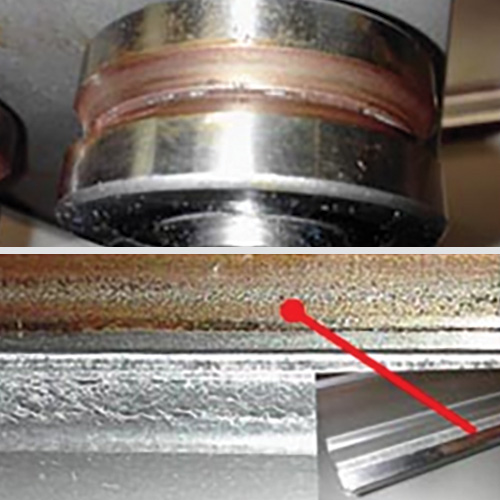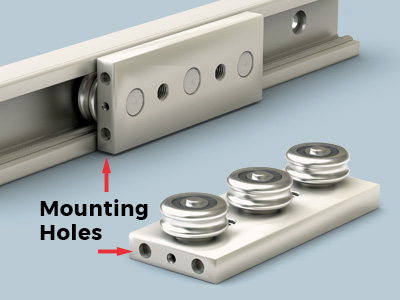Linear roller bearing systems offer advantages in applications where high speed or quick change of direction is required. Lubrication must be present to minimize the results of this metal-to metal contact and extend the life of the system.
All smaller rollers (in the Redi-Rail®, Integral-V™, V-Guide, Commercial Rail, Hardened Crown Roller families, and smaller diameter Hevi-Rail® bearings) are lubricated for long life. No additional lubrication is necessary. The rollers are sealed (or shielded) against the operating environment to prevent egress of lubricant and ingress of contaminants. Some larger rollers (i.e. Hevi-Rail family) are supplied with a grease access point and can be re-lubricated using a zerk fitting.
To ensure long life, it is always necessary to have a thin film of lubrication on the Raceway/Railway. When properly applied, lubrication:
Technical, environmental, ecological and economic factors will determine whether oil or grease should be used in an application. One of the most significant factors in the lubrication selected is the environmental conditions. If extreme conditions are expected, it is highly recommended that either PBC Linear or a representative from a lubrication company is consulted. This includes heavy contamination, when the expected particle size is smaller than 0.1 mm (0.005 in) as small particles can more easily bypass seals and wipers.

All metric Redi-Rail sizes now have a 4-wheel and 5-wheel carriage option. These product extensions will potentially offer:
Read our Redi-Rail Slider Carriage Load Capabilities blog for more detailed information on increased load capacities, or download the CRT Product Catalog to find specifications on all Redi-Rail products.
CAUTION! The compatibility of lubricants must always be checked. This check should be done under both static and dynamic conditions and within the operating environment. Some lubricants may have unexpected, negative reactions with the plastics, elastomers or non-ferrous metals within the products. It is possible to draw upon previous and practical experience or guidelines from the lubricant manufacturer. When in doubt, consult the lubricant manufacturer.
PBC Linear guides and raceways are shipped with a preservative lubrication applied to the raceway. During installation, it is necessary to apply additional lubrication. Provided there are no application conflicts, PBC recommends high quality lithium soap grease as the initial lubricant. This grease should be applied to the entire raceway, not just the portion used during normal operation. Oil or grease may be used for re-lubrication.
Note: coated/plated rails, Commercial Rail, Hardened Crown Roller and Hevi-Rail rails are typically shipped without any preservative lubrication. See the Hevi-Rail section for more details (sandblast and lightly oiled options are available for Hevi-Rail).
The lubrication interval is dependent on many operating and environmental conditions, such as load, stroke, velocity, acceleration, mounting position/orientation, type of lubrication used, temperature, humidity, UV exposure, etc. The actual lubrication interval should be determined by tests conducted under actual application conditions.
While the actual lubrication intervals are application specific and determined only through testing, the following guidelines can typically be used as a starting reference point under "normal" conditions:

Some PBC Linear products offer a high-quality polymer lubricator. PBC uses an advanced, oil filled porous polymer which has been tested to show better performance and longer life than similar wiper/lubricators made of oil or grease filled felt. In some applications, this special lubricator will last the life of the application without additional re-lubrication.
This lubricant within the polymer is NSF Registered for both H1 and H2 applications (direct and indirect contact with food). It can also be used for wash down and industrial applications. The lubrication within the polymer contains corrosion inhibitors, antioxidants and extreme pressure (E.P.) additives. Table 1, below, shows some specific properties for the lubricant.
Used lubricants should be disposed of using environmentally friendly methods. Most lubricant manufacturers have guidelines regarding their allowable storage, use and disposal. In addition, some countries have regulations regarding storage, use and disposal of lubricants for occupational safety and/or environmental protection. Furthermore, some companies may have adopted internationally accepted quality and standards policies (i.e. ISO14001) which will further regulate the use of lubricants within an application.
These guidelines and regulations must be followed. Care should be exercised as to not specify a lubricant which is forbidden.
Contamination and lack of lubrication are the two primary causes of (ball based) linear guide failures. Lack of lubrication will cause fretting corrosion which can cause permanent system damage and eventually lead to system failure. As it applies to this product, fretting corrosion is a form of damage caused as a combination of corrosion and abrasive wear. Fretting corrosion will typically be a reddish discoloration on either mating raceway (track or roller). Fretting corrosion can sometimes be confused with Rust. Both are signs that additional lubrication is necessary, and the re-lubrication period must be decreased.
While not recommended, it is possible to run most systems without lubrication; however, there will be significant reductions to maximum load, maximum speed and expected life. Table 2, below, shows that a typical un-lubricated system will have a significantly reduced maximum load and a reduced maximum speed when compared to a properly lubricated system.

In addition to significant reductions in maximum load and speed, un-lubricated system will also experience an extreme reduction in expected life. Table 3, below, shows the expected life for both a lubricated and un-lubricated system for two different products with different applied loads. The approximate reduction in lifetime has also been calculated.
For more information on minimizing corrosion and maximize the life of linear roller bearing systems, please see our white paper Lubrication for Linear Roller Bearings and Raceways
Note: Actual performance will vary depending upon specific application conditions. PBC Linear has removed the actual product name from the examples listed above as the results may not be repeatable, depending upon specific application conditions. While these values are typical, specific reductions should be determined by tests conducted under actual application conditions.

A lubrication option is now available at the time of purchase for all inch series Redi-Rail carriages. This allows customers to request factory-assembled lubrication to one or both sides of the carriage. Mounting holes are standard on all inch series carriages. Affected part numbers include RRS14PW and RRS18PW. Download our Redi-Rail product migration press release for more detailed information.